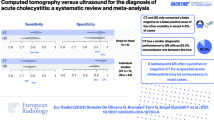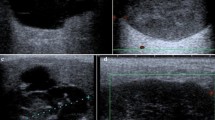Abstract
Objective
To explore whether multiple 3D computed tomography texture analysis (3D-CTTA) parameters can predict the therapeutic effects of holmium: YAG laser lithotripsy (LL) on ureteral calculi.
Methods
The files from 94 patients (102 stones) with proximal ureteral calculi treated only by LL at a single institution were retrospectively retrieved from January 2016 to March 2019. According to intra-operative observations and postoperative reexamination, samples were divided into a completely crushed and a non-crushed group. Preoperative non-contrast-enhanced computed tomography (NCCT) images obtained by multiple CT scanners were imported to MaZda software for 3D texture analysis (TA). The CT-derived value of each target stone was measured, and 15 TA parameters were extracted by delineating volumes of interest (VOIs). Receiver operating characteristic (ROC) curves were drawn to determine the optimal critical value of each parameter based on the Youden index, and univariable and multivariable logistic regression analyses determined the significant factors for LL success.
Results
In univariable analysis, significant differences (p < 0.05) were observed among 7 parameters. In multivariable analysis, Perc.01 3D > 2062 (p = 0.03) and Z-fraction of image in runs (Z-Fraction) > 0.45570 (p = 0.009) were significant independent predictors, with odds ratios (ORs) of 24.204 and 60.329, respectively. In subgroup analysis based on the cutoff value of the CT-derived value (HU = 960), Perc.01 3D (OR = 44.154, 95% CI (2.379, 819.618), p = 0.011) and Z-Fraction (OR = 14.519, 95% CI (2.088, 100.953), p = 0.007) remained statistically significant.
Conclusions
The combination of 3D-CTTA parameters and the CT-derived value can be used as a quantitative reference to predict whether a target stone could be completely crushed by LL.
Key Points
• Computed tomography texture analysis (CTTA) may be helpful in selecting suitable laser lithotripsy (LL) patients.
• 3D-CTTA better predicts stone fragility than commonly used methods (such as the CT-derived value).
• The combination of CTTA and the CT-derived value can be used as a preoperative quantitative reference.





Similar content being viewed by others
Change history
22 June 2021
A Correction to this paper has been published: https://doi.org/10.1007/s00330-021-08123-1
Abbreviations
- 3D-CTTA:
-
Three-dimensional computed tomography texture analysis
- LL:
-
Laser lithotripsy
- NCCT:
-
Non-contrast-enhanced computed tomography
- RLM:
-
Run length matrix
- ROI:
-
Region of interest
- VOI:
-
Volumes of interest
- Z-Fraction:
-
Z-fraction of image in runs
- Z-GLevNonU:
-
Z-gray-level non-uniformity
- Z-LngREmph:
-
Z-long run emphasis
- Z-RLNonUni:
-
Z-run length non-uniformity
- Z-ShrtREmp:
-
Z-short run emphasis
References
Chen S, Zhou L, Wei T et al (2017) Comparison of holmium: YAG laser and pneumatic lithotripsy in the treatment of ureteral stones: an update meta-analysis. Urol Int 98:125–133
Enikeev DV, Alyaev YG, Rapoport LM, Taratkin MS, Laukhtina EA, Glybochko PV (2019) [Multidisciplinary approach in urology. Laser technologies: faster, simpler, more efficient]. Urologiia 4:7–11
Kronenberg P, Traxer O (2015) Update on lasers in urology 2014: current assessment on holmium:yttrium-aluminum-garnet (Ho:YAG) laser lithotripter settings and laser fibers. World J Urol 33:463–469
Ofude M, Shima T, Yotsuyanagi S, Ikeda D (2017) Stone attenuation values measured by average Hounsfield units and stone volume as predictors of total laser energy required during ureteroscopic lithotripsy using holmium: yttrium-aluminum-garnet lasers. Urology 102:48–53
European Association of Urology (2020) European association of urology (EAU) guidelines on urolithiasis. Available via https://uroweb.org/guideline/urolithiasis/. Accessed 4 Jun 2020
Kreshover JE, Dickstein RJ, Rowe C, Babayan RK, Wang DS (2011) Predictors for negative ureteroscopy in the management of upper urinary tract stone disease. Urology 78:748–752
Ito H, Kawahara T, Terao H et al (2013) Evaluation of preoperative measurement of stone surface area as a predictor of stone-free status after combined ureteroscopy with holmium laser lithotripsy: a single-center experience. J Endourol 27:715–721
Fang X, Li X, Bian Y, Ji X, Lu J (2020) Radiomics nomogram for the prediction of 2019 novel coronavirus pneumonia caused by SARS-CoV-2. Eur Radiol. https://doi.org/10.1007/s00330-020-07032-z
Zhang G, Xu L, Zhao L et al (2020) CT-based radiomics to predict the pathological grade of bladder cancer. Eur Radiol. https://doi.org/10.1007/s00330-020-06893-8
Hodgdon T, Thornhill RE, James ND, Beaule PE, Speirs AD, Rakhra KS (2020) CT texture analysis of acetabular subchondral bone can discriminate between normal and cam-positive hips. Eur Radiol. https://doi.org/10.1007/s00330-020-06781-1
Wei W, Hu XW, Cheng Q, Zhao YM, Ge YQ (2020) Identification of common and severe COVID-19: the value of CT texture analysis and correlation with clinical characteristics. Eur Radiol. https://doi.org/10.1007/s00330-020-07012-3
Mannil M, von Spiczak J, Hermanns T, Poyet C, Alkadhi H, Fankhauser CD (2018) Three-dimensional texture analysis with machine learning provides incremental predictive information for successful shock wave lithotripsy in patients with kidney stones. J Urol 200:829–836
Cui HW, Devlies W, Ravenscroft S et al (2017) CT texture analysis of ex vivo renal stones predicts ease of fragmentation with shockwave lithotripsy. J Endourol 31:694–700
Szczypinski PM, Strzelecki M, Materka A, Klepaczko A (2009) MaZda--a software package for image texture analysis. Comput Methods Programs Biomed 94:66–76
Rizzo S, Botta F, Raimondi S et al (2018) Radiomics: the facts and the challenges of image analysis. Eur Radiol Exp 2:36
Wang M, Perucho JAU, Tse KY, Chu MMY, Ip P, Lee EYP (2020) MRI texture features differentiate clinicopathological characteristics of cervical carcinoma. Eur Radiol. https://doi.org/10.1007/s00330-020-06913-7
Baessler B, Luecke C, Lurz J et al (2019) Cardiac MRI and texture analysis of myocardial T1 and T2 maps in myocarditis with acute versus chronic symptoms of heart failure. Radiology 292:608–617
Ahn SJ, Kim JH, Lee SM, Park SJ, Han JK (2019) CT reconstruction algorithms affect histogram and texture analysis: evidence for liver parenchyma, focal solid liver lesions, and renal cysts. Eur Radiol 29:4008–4015
(2007) The 2007 Recommendations of the International Commission on Radiological Protection. ICRP publication 103. Ann ICRP 37:1–332
Ferrero A, Montoya JC, Vaughan LE et al (2016) Quantitative prediction of stone fragility from routine dual energy CT: ex vivo proof of feasibility. Acad Radiol 23:1545–1552
Mannil M, von Spiczak J, Hermanns T, Alkadhi H, Fankhauser CD (2018) Prediction of successful shock wave lithotripsy with CT: a phantom study using texture analysis. Abdom Radiol (NY) 43:1432–1438
Wu S, Zheng J, Li Y et al (2017) A radiomics nomogram for the preoperative prediction of lymph node metastasis in bladder cancer. Clin Cancer Res 23:6904–6911
Huang YQ, Liang CH, He L et al (2016) Development and validation of a radiomics nomogram for preoperative prediction of lymph node metastasis in colorectal cancer. J Clin Oncol 34:2157–2164
El-Assmy A, El-Nahas AR, Youssef RF, El-Hefnawy AS, Sheir KZ (2007) Impact of the degree of hydronephrosis on the efficacy of in situ extracorporeal shock-wave lithotripsy for proximal ureteral calculi. Scand J Urol Nephrol 41:208–213
Gupta NP, Ansari MS, Kesarvani P, Kapoor A, Mukhopadhyay S (2005) Role of computed tomography with no contrast medium enhancement in predicting the outcome of extracorporeal shock wave lithotripsy for urinary calculi. BJU Int 95:1285–1288
Sun K, Zhu H, Chai W et al (2020) Whole-lesion histogram and texture analyses of breast lesions on inline quantitative DCE mapping with CAIPIRINHA-Dixon-TWIST-VIBE. Eur Radiol 30:57–65
Ren J, Yuan Y, Qi M, Tao X (2020) Machine learning-based CT texture analysis to predict HPV status in oropharyngeal squamous cell carcinoma: comparison of 2D and 3D segmentation. Eur Radiol. https://doi.org/10.1007/s00330-020-07011-4
Xu H, Guo W, Cui X et al (2019) Three-dimensional texture analysis based on PET/CT images to distinguish hepatocellular carcinoma and hepatic lymphoma. Front Oncol 9:844
Sandrasegaran K, Lin Y, Asare-Sawiri M, Taiyini T, Tann M (2019) CT texture analysis of pancreatic cancer. Eur Radiol 29:1067–1073
Ito H, Kawahara T, Terao H et al (2012) Predictive value of attenuation coefficients measured as Hounsfield units on noncontrast computed tomography during flexible ureteroscopy with holmium laser lithotripsy: a single-center experience. J Endourol 26:1125–1130
Lee JY, Kim JH, Kang DH et al (2016) Stone heterogeneity index as the standard deviation of Hounsfield units: a novel predictor for shock-wave lithotripsy outcomes in ureter calculi. Sci Rep 6:23988
Yamashita S, Kohjimoto Y, Iguchi T et al (2017) Variation coefficient of stone density: a novel predictor of the outcome of extracorporeal shockwave lithotripsy. J Endourol 31:384–390
Cui HW, Silva MD, Mills AW, North BV, Turney BW (2019) Predicting shockwave lithotripsy outcome for urolithiasis using clinical and stone computed tomography texture analysis variables. Sci Rep 9:14674
Yamashita S, Kohjimoto Y, Iwahashi Y et al (2018) Noncontrast computed tomography parameters for predicting shock wave lithotripsy outcome in upper urinary tract stone cases. Biomed Res Int 2018:9253952
Basulto-Martinez M, Klein I, Gutierrez-Aceves J (2019) The role of extracorporeal shock wave lithotripsy in the future of stone management. Curr Opin Urol 29:96–102
Torricelli FC, Marchini GS, Yamauchi FI et al (2015) Impact of renal anatomy on shock wave lithotripsy outcomes for lower pole kidney stones: results of a prospective multifactorial analysis controlled by computerized tomography. J Urol 193:2002–2007
Guler Y, Erbin A, Kafkasli A, Ozmerdiven G (2020) Factors affecting success in the treatment of proximal ureteral stones larger than 1 cm with extracorporeal shockwave lithotripsy in adult patients. Urolithiasis. https://doi.org/10.1007/s00240-020-01186-7
Maalouf NM, Sato AH, Welch BJ et al (2010) Postmenopausal hormone use and the risk of nephrolithiasis: results from the Women’s Health Initiative hormone therapy trials. Arch Intern Med 170:1678–1685
Acknowledgments
Thanks to all the authors. In particular, we would like to thank Haiyi Wang. MD (Department of Radiology, First Medical Center, Chinese PLA General Hospital) for his advice during the project.
Funding
The authors state that this work has not received any funding.
Author information
Authors and Affiliations
Corresponding author
Ethics declarations
Guarantor
The scientific guarantor of this publication is Yunshan Su.MD.
Conflict of interest
The authors of this manuscript declare no relationships with any companies whose products or services may be related to the subject matter of the article.
Statistics and biometry
No complex statistical methods were necessary for this paper.
Informed consent
Written informed consent was waived by the Institutional Review Board.
Ethical approval
Institutional Review Board approval was obtained.
Methodology
• retrospective
• diagnostic or prognostic study
• performed at one institution
Additional information
Publisher’s note
Springer Nature remains neutral with regard to jurisdictional claims in published maps and institutional affiliations.
Rights and permissions
About this article
Cite this article
Wang, R., Su, Y., Mao, C. et al. Laser lithotripsy for proximal ureteral calculi in adults: can 3D CT texture analysis help predict treatment success?. Eur Radiol 31, 3734–3744 (2021). https://doi.org/10.1007/s00330-020-07498-x
Received:
Revised:
Accepted:
Published:
Issue Date:
DOI: https://doi.org/10.1007/s00330-020-07498-x




